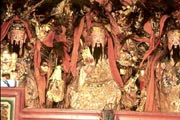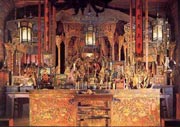 As you enter the temple, the ornate wooden gate to the porch and the fanciful gables and cornices on the building set the Asian theme. The front of the building is painted bright blue with white lines to resemble the tile on the temple's Chinese prototype. Just beyond the two large doors, the entrance to the temple proper, are two more high wooden doors, "spirit screens" to keep out evil spirits. According to traditional Chinese belief, such spirits can go only in straight lines, not around corners.
As you enter the temple, the ornate wooden gate to the porch and the fanciful gables and cornices on the building set the Asian theme. The front of the building is painted bright blue with white lines to resemble the tile on the temple's Chinese prototype. Just beyond the two large doors, the entrance to the temple proper, are two more high wooden doors, "spirit screens" to keep out evil spirits. According to traditional Chinese belief, such spirits can go only in straight lines, not around corners.
There are three ornately carved wooden canopies containing images of gods along the back wall opposite the spirit screens, and in front of them is an alter holding candies, incense sticks, oracle fortune sticks and oracle books, wine cups, and pictures of immortals painted on glass. Before this alter is a small wooden table on which food offerings are placed and a stone urn used to offer alcoholic beverages.
 The god Dai Tze, a smiling and friendly-looking figure, guards the entrance of the temple, just to the right of the inner spirit screen. Dai Tze and most of the figures in the temple were said to have been living persons who were made gods as a reward for exemplary lives. Inside the temple there is a rich collection of religious artifacts, including the "Dogs of Foo," who guard the two altars, to either side of the main altar. They are hand carved of wood, painted red, and overlaid with gilt. A male dog to the right of each altar has his right foot poised on a ball, symbolizing his guardianship of the world. The female dog to the left extends her left paw to protect a puppy. The temple also contains the sacred figures Leong Mar and Kwan Yin, which were recently restored. The two altar figures were important symbols for gold-seeking Chinese in California and Trinity County. Leong Mar represents safe travel for seafarers who made the long voyage across the ocean from China to stake their gold claims. Kwan Yin represents mercy, a highly desirable quality, considering the challenges these individuals faced.
The god Dai Tze, a smiling and friendly-looking figure, guards the entrance of the temple, just to the right of the inner spirit screen. Dai Tze and most of the figures in the temple were said to have been living persons who were made gods as a reward for exemplary lives. Inside the temple there is a rich collection of religious artifacts, including the "Dogs of Foo," who guard the two altars, to either side of the main altar. They are hand carved of wood, painted red, and overlaid with gilt. A male dog to the right of each altar has his right foot poised on a ball, symbolizing his guardianship of the world. The female dog to the left extends her left paw to protect a puppy. The temple also contains the sacred figures Leong Mar and Kwan Yin, which were recently restored. The two altar figures were important symbols for gold-seeking Chinese in California and Trinity County. Leong Mar represents safe travel for seafarers who made the long voyage across the ocean from China to stake their gold claims. Kwan Yin represents mercy, a highly desirable quality, considering the challenges these individuals faced.
The temple has been in continuous use as a place of worship since its construction. Worshipers visit the temple alone, with their families, or with a small group of close friends to pray and to place some incense, candles and other offerings such as food and paper money before the images of the gods of Health, Decision, or Mercy. Worshippers are forbidden to pray for such things as wealth (though they might ask for help in making the right business decision) or revenge on an enemy.
Connected to the temple building is another structure, containing a conference room sometimes used as a Chinese courtroom and two small rooms that served as the temple attendant's quarters. Despite the cramped accommodations, the post of temple attendant was eagerly sought. It was auctioned off to the highest bidder for as much as $600.
